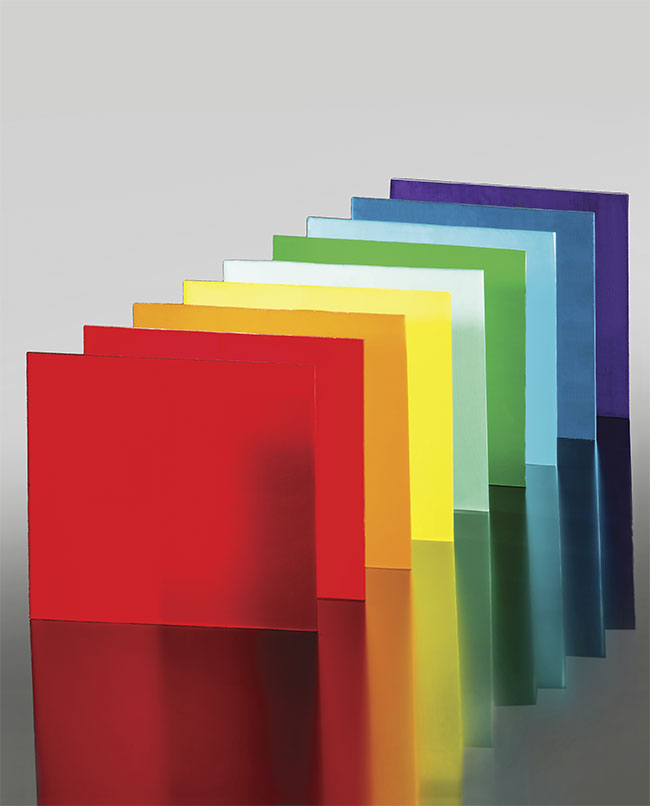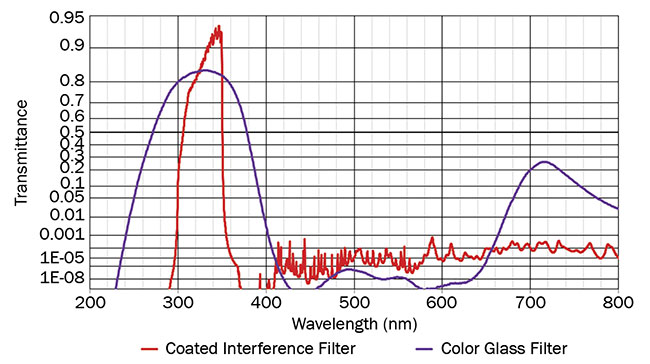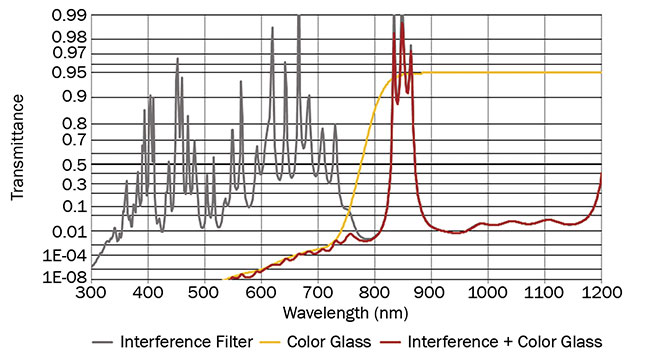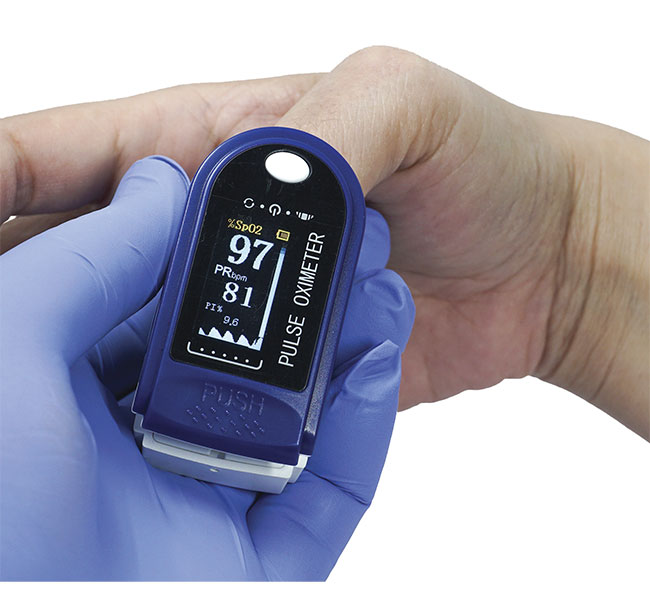Color glass filters offer advantages over coated filters in certain life science applications, but selecting the best option requires close consideration of several factors.
KATHRIN CALLAGHAN, EDMUND OPTICS LTD., AND RALF BIERTÜMPFEL, SCHOTT AG
Optical filters are critical for selectively passing and blocking specific wavelengths in life science applications ranging from monitoring oxygen and pH levels in blood to fluorescence detection, to the polymerase chain reaction (PCR) tests used to detect COVID-19, to UV sterilization. Color glass filters and coated dielectric filters are both utilized in life science systems. Understanding the advantages and disadvantages of each filter type ensures that system designers can achieve the required performance for their application. When using color glass filters, several key considerations regarding chemical and mechanical properties should also be kept in mind to select the proper solution.

Figure 1. Color glass filters feature broadband blocking of undesired wavelengths, a cost-effective price point, and insensitivity to angle of incidence or polarization. Courtesy of SCHOTT AG.
Color glass filters
Color glass filters use substrates that incorporate elements, dyes, or other colorants that absorb desired wavelength ranges while transmitting others (Figure 1). The amount of absorption is dependent on the substrate thickness and the colorants it incorporates. These filters can have a wide variety of functions, including bandpass, shortpass, longpass, or neutral density filtering. They are ideal for blocking a wide range of wavelengths, as it is difficult and expensive to achieve strong blocking over a large wavelength range using coated interference filters (Figure 2).

Figure 2. Performance data for a coated interference filter shows higher peak transmission and
sharper spectral cut-on and cut-off transitions than data shown for a comparable color glass filter.
But the color glass filter has been proved to block unwanted wavelengths to a much higher extent.
The UG11 glass in this plot blocks light between 420 and 640 nm, with an optical density of 6 (meaning transmittance is lower than 10−6). The increased fluctuations in the visible spectrum of the coated
filter are likely due to spectrophotometer noise. Courtesy of Edmund Optics and SCHOTT AG.
Color glass filters are also less expensive than coated filters, in general, allowing them to be more easily deployed in low-cost, portable life science systems designed for use in the field. Their performance is independent of the angle of incidence or polarization, making alignment and polarization less important considerations than they are for coated filters.
The absorptive colorant in colored glass is distributed homogeneously throughout the filter substrate, rather than being applied as a surface-level coating. Filter glasses gain their properties either from ions fixed in the glass matrix or from colloidal semiconductor nanocrystals. This makes color glass filters usable at higher temperatures than coated filters, as well as being easier to clean.
The fact that color glass filters absorb rather than reflect rejected light prevents their use in high-power laser systems, but this quality can be beneficial for reducing stray light. If the power of incident light is too high, heat may build up that can cause the filter to deform.
Color glass filters also have their share of other disadvantages when compared
to coated filters. Color glass may function across broad wavelength ranges, but
dielectric coatings typically achieve higher transmission of passed wavelengths and sharper transitions between blocked and passed wavelengths. Because the performance of color glass filters depends on thickness, these filters need to be polished to a very specific thickness in order to dial in a certain spectral performance. If the required thickness
is not available as a standard part, the filter may need custom polishing. Additionally, in a miniaturized setup where space is limited, a filter with several millimeters of thickness sometimes cannot be used. The relationship between filter transmittance and thickness can be described by:

where τd1 is transmittance at a thickness of d1, P(λ) is a wavelength-dependent reflection factor, and τd2 (λ) is transmittance at measured reference thickness d2.
Coated interference filters
Coated interference filters utilize dielectric coatings to reflect unwanted light while minimizing absorption. Although color glass filters are ideal solutions for broadband and cost-sensitive applications, coated interference filters provide ideal solutions for high-performance applications requiring maximum throughput and sharp spectral transitions. Coatings can accurately pass or block a narrow band of wavelengths, if needed.

Filter glass manufacturers use acid-resistance classes to characterize the sensitivity of different glass types.
Dichroic interference coatings reflect unwanted wavelengths but allow useful radiation to travel through the optical system. In fluorescence applications this is beneficial because excitation wavelengths can be reflected onto the sample while longer emitted wavelengths are allowed to pass through the filter to reach the detector. These rejected wavelengths may contribute to stray light, however.
Because coated interference filters
do not absorb light, they are less heat-sensitive than color filter glass and are more compatible with lasers and other high-power light sources. Interference filters are made of alternating thin-film layers, and an entire stack may have a thickness of only a few micrometers, which enables these filters to accommodate incredibly small designs.
Yet, as stated earlier, coated interference filters have some disadvantages compared to color filter glass. Coated filters are angle- and polarization-dependent, making their application less flexible and only compatible with a certain set of operating conditions. Because an optical interference filter is tilted away from normal incidence, the transmission spectrum is “blue shifted,” meaning that the spectral features shift to shorter wavelengths (Figure 3). This shift becomes more pronounced with increasing angles of incidence.

Figure 3. Transmittance through various filter technologies. The color glass filter has a perfect
antireflection coating on one surface, while the interference + color glass filter is coated on
both surfaces. Courtesy of SCHOTT AG.
The operational temperature range of interference filter coatings is usually lower than that of color glass, and it varies for different thin-film designs. In addition, UV coatings are often more prone to damage and difficult to clean, making them better suited for use in precise lab equipment as opposed to lower-cost, portable devices.
In counterpoint, coatings can be optimized to be more scratch-resistant, or they can be formulated with a special chemistry to be more inert. Often, dielectric coatings are even added to color glass filters when both broadband and strong blocking are required. Both the coating and color glass substrate filter reduce the overall amount of light throughput, but these hybrid solutions offer both sharp transitions and wide wavelength coverage (Figure 3).
Choosing color filters
Their broad blocking ability, cost-effective price point, and insensitivity to angle of incidence and polarization make color glass filters ideal for a number of life science applications in which very narrow bandwidths are not needed, such as blood gas monitoring, ophthalmology, and other diagnostic equipment systems (Figure 4).

Figure 4. A portable oximeter is used to measure oxygen levels and pulse rate. Portable, low-cost life science devices particularly benefit from incorporating color glass filters. Courtesy of Edmund Optics.
While optical filter glass is often
described as “color” glass, it is unlike
architectural glass in that it is not designed to have a pleasant, visible color. Instead, the key characteristic of these filters is the preciseness and homogeneity of their transmission spectrum. Optical filter glasses have a high internal quality, allowing their use in simple sensing applications as well as in high-resolution imaging. The lifetime of filter glass under normal conditions can be as long as centuries.
Chemical properties
When specifying color glass filters, several key considerations will ensure that the filter performs optimally in the system or application. The chemical properties of different substrates can vary, and the potential impacts of these material characteristics are especially important to consider in systems used outside of a controlled laboratory setting. There could also be batch-to-batch variations in the chemical properties of the same color filter glass, depending on the melt it comes from.
This raises considerations around corrosion resistance and other chemical parameters for filters used in portable blood oximeters, pH meters, and other diagnostic equipment that may be exposed to humidity and contaminants. The chemical properties of filters affect not only how end components are used, but also how they should be stored.
Different glass manufacturers specify material properties in different ways, but resistance class numbers are often used to describe the material’s chemical properties. Lower class numbers indicate higher resistances1. Sensitive glass types may form a slightly cloudy residue over time due to moisture exposure. The initial buildup of this residue can be removed through polishing, but significant residue development caused by prolonged exposure to warm humidity may ruin the
filter’s surface quality. Similarly, exposing a filter to slightly acidic water can sometimes induce a chemical reaction, in which ions are exchanged between hydronium ions in the water and cations in the color glass. These interactions can potentially create stains on the surface
of filters.
ISO 8424 defines acid resistance as
the behavior of glass after exposure to large amounts of acidic solutions through laminating substances, carbonated water, perspiration of the glass, and other
methods2. The acid-resistance class of a color glass filter describes effects resulting from acid beyond those described
in the stain-resistance class (see table
on page 49). ISO 10629 similarly describes the sensitivity of glass to reactions to alkaline liquids, including cooling liquids commonly used for grinding
and polishing3.
Additionally, extended exposure to sunlight or other intense UV radiation may result in solarization, which can permanently reduce the transmission of color glass filters. The amount of solarization is dependent on the spectra of the UV source, its intensity, the duration of exposure, and the glass’s solarization
resistance. Solarization typically results in a shift of the shortwave-located edge of the passed waveband to longer wavelengths and an overall decrease in the transmitted bandwidth. When listed on datasheets, glasses more prone to solarization are often marked by a symbol flagging this concern for applications
exposed to UV radiation. It should be noted that the solarization of glass is an effect that does not destroy the glass
matrix. Instead, it just changes the transmittance properties. This is very different for plastic materials, which degrade and
get brittle.
When selecting filters for an application, it is wise to review the chemical-
resistance classes reported in the supplier’s datasheets and to contact the
supplier to discuss what classes are sufficient for the application. The supplier should be able to identify the right color glass filter substrates for a particular
system, recommend any additional protective coatings that may be required,
and provide direction to additional solutions, if needed.
Mechanical properties
Filters often require certain mechanical properties in situations where they may
be exposed to mechanical stresses, dust, or other physical contact. The Knoop hardness of a filter describes its resistance to indentation and abrasion. To test for resistance, a diamond tool is typically pressed into a filter at a test force of 0.9807 N and an effective test period of 20 s following ISO 9285 protocols4. Again, this concern is more important for portable life science devices used outside of a laboratory setting because of their increased exposure to mechanical contact and contaminants.
The strength of glass, which describes the amount of force that can be applied per unit area until the glass breaks, is not a purely material-dependent property.
Unlike with metals or plastics, the strength of glass is dependent on both the substrate material and its surface quality. Scratches on the surface of the filter and chips in its edges may decrease the component’s strength tremendously.
In addition to strictly mechanical properties, thermal characteristics such as thermal expansion and stress induced by uneven heating of the filter may factor into certain applications. Glasses can withstand high temperatures, but they are sensitive to thermal shock or large temperature gradients within the component. As with chemical properties, mechanical
and thermal characteristics are often listed on datasheets provided by the glass manufacturer and offer a great starting place for understanding how these parameters can influence filter selection for a particular application.
Understanding the various filter technologies available, their advantages and disadvantages, and which material properties to look for will aid selection
of the proper filters for any application.
In systems where broad blocking, cost-effectiveness, and insensitivity to angle and polarization are needed, color glass filters are often ideal solutions.
Meet the authors
Kathrin Callaghan, Ph.D., has been the product line manager for polarization optics and
diffraction gratings at Edmund Optics Ltd. since 2017. She has eight years of postdoctoral and professional experience in the life sciences and optical technologies, particularly microscopy and spectroscopy; email: [email protected].
Ralf Biertümpfel, Ph.D., joined SCHOTT AG in 2001 as a developer for hot-forming precision optics. He later became a scientist focusing on optical filters and, in 2015, he became the product manager for optical filters in SCHOTT’s Advanced Optics business unit; email: [email protected].
References
1. SCHOTT AG (SCHOTT Advanced Optics) (2020). Optical Filter Glass, www.schott.com/en-us/products/optical-filter-glass.
2. International Organization for Standardization (2018). Raw optical glass — Resistance to attack by aqueous acidic solutions at
25 degrees C — Test method and classification (ISO 8424).
3. International Organization for Standardization (2018). Raw optical glass — Resistance to attack by aqueous alkaline solutions at
50 degrees C — Test method and classification (ISO 10629).
4. International Organization for Standardization (2018). Abrasive grains and crude — Chemical analysis of fused aluminium oxide (ISO 9285).